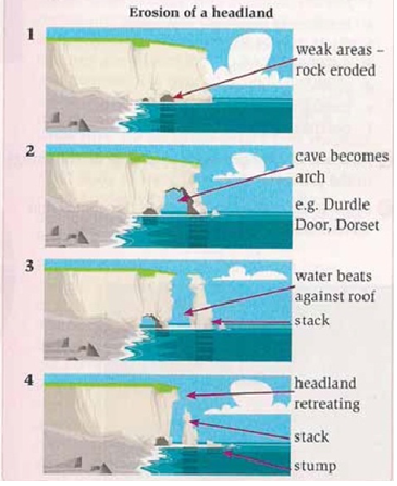A breakdown of the erosion process in a headland is presented in the diagram. Overall, it is clearly seen that time by time the headland gradually disappears, and the process continues for some natural steps without any affection of human.
To begin, beneath the base of the headland, there are weak areas, hollow lands caused by erosion, which is like a small cave. After that, the hollow land becomes huger, so the cave turns arch, where it is possibly shaped like Durdle, door, or Dorset. After the sea water beats against the hollow lands for long time, the roof of the headland disappears, and it gets wicker and wicker.
Following that, after being eroded, the stack area is separated from the headland. Whereas a frequency of water pressure causes a powerless area. Eventually, the roof of the separated land retreats, which effects virtually a half of the size lost. Consequently, the stack land falls into the sea, and creates stump.
To begin, beneath the base of the headland, there are weak areas, hollow lands caused by erosion, which is like a small cave. After that, the hollow land becomes huger, so the cave turns arch, where it is possibly shaped like Durdle, door, or Dorset. After the sea water beats against the hollow lands for long time, the roof of the headland disappears, and it gets wicker and wicker.
Following that, after being eroded, the stack area is separated from the headland. Whereas a frequency of water pressure causes a powerless area. Eventually, the roof of the separated land retreats, which effects virtually a half of the size lost. Consequently, the stack land falls into the sea, and creates stump.

asd.png
